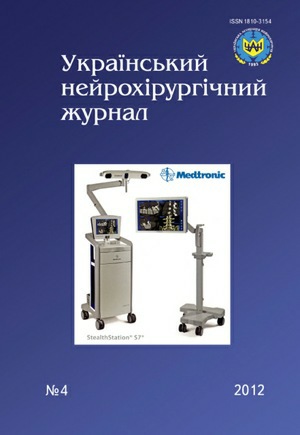Features of supratentorial primitive neuroectodermal tumors in young children
DOI:
https://doi.org/10.25305/unj.55647Keywords:
brain tumors, supratentorial primitive neuroectodermal tumors, surgery, chemotherapy, young childrenAbstract
Introduction. Supratentorial primitive neuroectodermal tumors (sPNET) are highly malignant neoplasms with much more worse prognosis than at medulloblastomas. A retrospective analysis of treatment in the clinic of children under 3 years with sPNETs are given.
Materials and methods. In the period from 1998 and 2009 years, 20 children under 3 years with sPNET, there were 10 boys and 10 girls have been treated in the clinic — 4.6% of all infants with brain tumors, diagnosed for that period of time.
Results. Total tumor resection was performed in 6 (30%) patients, subtotal — in 6 (30%), partial — in 6 (30%), in 2 — biopsy was made. Postoperative lethality — 22%. In 9 (45%) observations the tumor was classified as cerebral neuroblastoma, in 1 (5%) — as cerebral ganglioneuroblastoma. Tumor cells in liquor were found in 11.8% cases, metastasis in other parts of the brain — in 15%, extraneural dissemination — in 2 patients. 11 (73.3%) underwent chemotherapy, 3 (20%) — radiation therapy. Follow-up data from 1 year to 7 years are available in 86.7% patients. The median survival was 42 months, 2- and 5-year survival — 61.5 and 15.4% respectively, recurrence rate — 20%.
Conclusions. sPNET in children are relatively rare, they are one of the most malignant brain tumors. Chemotherapy inclusion into complex treatment promotes survival prolongation. To improve results of treatment in children with sPNET further search for effective complex of combined treatment of such tumors is required, especially in young children.
References
1. Berger M, Magrassi L, Geyer R. Medulloblastoma and primitive neuroectodermal tumors. In: Kaye A, Laws E, ed. Brain Tumors. An Encyclopedic Approach. Edinburgh: Churchill Livingstone; 1995:561-574.
2. Rosemberg S, Fujiwara D. Epidemiology of pediatric tumors of the nervous system according to the WHO 2000 classification: a report of 1,195 cases from a single institution. Childs Nerv Syst. 2005;21(11):940-944. [CrossRef] [PubMed]
3. Li M, Bouffet E, Hawkins C, Squire J, Huang A. Molecular genetics of supratentorial primitive neuroectodermal tumors and pineoblastoma. Neurosurgical FOCUS. 2005;19(5):1-17. [CrossRef] [PubMed]
4. Albright L, Wisoff J, Zeltzer P et al. Prognostic Factors in Children with Supratentorial (Nonpineal) Primitive Neuroectodermal Tumors. Pediatric Neurosurgery. 1995;22(1):1-7. [CrossRef]
5. Gurney J, Smith M, Bunin G. CNS and miscellaneous intracranial and intraspinal neoplasms. In: Ries L, Gurney M, Smith G, ed. Cancer Incidence And Survival Among Children And Adolescents: United States SEER Program 1975—1995, National Cancer Institute, SEER Program. 1st ed. Bethesda: NIH Publ.; 1999:99-4646.
6. McNeil D, Cote T, Clegg L, Rorke L. Incidence and trends in pediatric malignancies medulloblastoma/primitive neuroectodermal tumor: A SEER update. Med Pediatr Oncol. 2002;39(3):190-194. [CrossRef] [PubMed]
7. Weil M. Influence of a Childs Sex on Medulloblastoma Outcome. JAMA. 1998;279(18):1474-1476. [CrossRef] [PubMed]
8. Fangusaro J, Finlay J, Sposto R et al. Intensive chemotherapy followed by consolidative myeloablative chemotherapy with autologous hematopoietic cell rescue (AuHCR) in young children with newly diagnosed supratentorial primitive neuroectodermal tumors (sPNETs): Report of the Head Start I and II experience. Pediatr Blood Cancer. 2008;50(2):312-318. [CrossRef] [PubMed]
9. Tarbell N, Loeffler J, Silver B et al. The change in patterns of relapse in medulloblastoma. Cancer. 1991;68(7):1600-1604. [CrossRef] [PubMed]
Downloads
Published
How to Cite
Issue
Section
License
Copyright (c) 2012 Yuriy Orlov, Andrii Shaverskyi, Аndriy Svyst, Volodymyr Mykhalyuk, Vadim Zyabchenko, Tatyana Malysheva, Oksana Chernenko, S. Dovzhenko

This work is licensed under a Creative Commons Attribution 4.0 International License.
Ukrainian Neurosurgical Journal abides by the CREATIVE COMMONS copyright rights and permissions for open access journals.
Authors, who are published in this Journal, agree to the following conditions:
1. The authors reserve the right to authorship of the work and pass the first publication right of this work to the Journal under the terms of Creative Commons Attribution License, which allows others to freely distribute the published research with the obligatory reference to the authors of the original work and the first publication of the work in this Journal.
2. The authors have the right to conclude separate supplement agreements that relate to non-exclusive work distribution in the form of which it has been published by the Journal (for example, to upload the work to the online storage of the Journal or publish it as part of a monograph), provided that the reference to the first publication of the work in this Journal is included.









